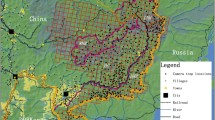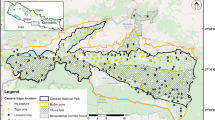Abstract
We investigated predictions concerning the competitive relationships between tigers Panthera tigris and leopards Panthera pardus in Bardia National Park, Nepal, based on spatial distributions of scats and territorial markings (sign), analyses of scat content and census of wild ungulate prey. Medium-sized ungulates, in particular chital Axis axis, was the main food of both predators, but leopards consumed significantly larger proportions of domestic animals, small mammals, and birds than tigers. Tiger sign were never found outside the park, while leopard sign occurred both inside and outside, and were significantly closer to the park border than tiger sign. Significantly higher prey densities at locations of tiger sign than that of leopards were mainly due to a preference of the latter species for the park border areas. Our results imply that interference competition––and not competition for food––was a limiting factor for the leopard population, whose distribution was restricted to the margins of the tiger territories. We suggest that the composition of the prey base is a key factor in understanding the different results and interpretations reported in studies on tiger/leopard coexistence. There are two potential mechanisms that link interference competition and prey: (1) low abundance of large ungulate prey decreases foraging efficiency of tigers, leading to increased energetic stress and aggression towards leopards; and (2) increased diet overlap due to scarcity of large prey leads to increased encounter rates and increased levels of interference competition.

Similar content being viewed by others
References
Andheria AP, Karanth KU, Kumar NS (2007) Diet and prey profiles of three sympatric large carnivores in Bandipur Tiger Reserve, India. J Zool 273:169–175
Athreya V (2006) Is relocation a viable management option for unwanted animals? The case of the leopard in India. Conserv Soc 4:419–423
Begon M, Harper JL, Townsend CR (1990) Ecology: individuals, populations and communities, 2nd edn. Blackwell, Cambridge
Burnham KP, Anderson DR (2002) Model selection and multimodel inference: a practical information-theoretic approach, 2nd edn. Springer, Berlin
Creel S, Spong G, Creel NM (2001) Interspecific competition and the population biology of extinction-prone carnivores. In: Gittleman J, Macdonald D, Funk S, Wayne R (eds) Conservation of carnivores. Cambridge University Press, Cambridge, pp 35–60
Donadio E, Buskirk SW (2006) Diet, morphology and interspecific killing in carnivora. Am Nat 167:524–536
Durant SM (1998) Competition refuges and coexistence: an example from Serengeti carnivores. J Anim Ecol 67:370–386
Edgaonkar A, Chellam R (2002) Food habit of the leopard, Panthera pardus, in the Sanjay Gandhi National Park, Maharashtra, India. Mammalia 66:353–360
Gittleman JL (1985) Carnivore body size––ecological and taxonomic correlates. Oecologia 67:540–554
Goss-Custard JD (1980) Competition for food and interference amongst waders. Ardea 68:31–52
Hayward MW, Henschel P, O’Brien J, Hofmeyr M, Balme G, Kerley GIH (2006) Prey preferences of the leopard (Panthera pardus). J Zool 270:298–313
Heinen JT, Kattel B (1992) Parks, people and conservation: a review of management issues in Nepal’s protected areas. Popul Environ 14:49–84
Karanth KU (1993) Predator–prey relationships among large mammals of Nagarahole National Park, India. PhD Dissertation, Mangalore University, Mangalore, India
Karanth KU (1995) Estimating tiger Panthera tigris populations from camera-trap data using capture–recapture models. Biol Cons 71:333–338
Karanth KU, Nichols JD (1998) Estimation of tiger densities in India using photographic captures and recaptures. Ecology 79:2852–2862
Karanth KU, Stith BM (1999) Prey depletion as a critical determinant of tiger population viability. In: Seidensticker J, Christie S, Jackson P (eds) Riding the tiger: tiger conservation in human dominated landscapes. Cambridge University Press, Cambridge, pp 100–113
Karanth KU, Sunquist ME (1992) Population structure, density and biomass of large herbivores in the tropical forests of Nagarahole, India. J Trop Ecol 8:21–35
Karanth KU, Sunquist ME (1995) Prey selection by tiger, leopard and dhole in tropical forests. J Anim Ecol 64:439–450
Karanth KU, Sunquist ME (2000) Behavioural correlates of predation by tiger (Panthera tigris), leopard (Panthera pardus) and dhole (Cuon alpinus) in Nagarahole, India. J Zool 250:255–265
Liao JG, McGee D (2003) Adjusted coefficients of determination for logistic regression. Am Stat 57:161–165
MacArthur RH, Levins R (1967) The limiting similarity, convergence and divergence of coexisting species. Am Nat 101:377–385
McDougal C (1988) Leopard and tiger interactions at Royal Chitwan National Park, Nepal. J Bombay Nat Hist Soc 85:609–610
Mukherjee SP, Goyal SP, Chellam R (1994a) Refined techniques for the analysis of Asiatic lion Panthera leo persica scats. Acta Theriol 39:425–430
Mukherjee SP, Goyal SP, Chellam R (1994b) Standardisation of scat techniques for leopard (Panthera pardus) in Gir National Park, Western India. Mammalia 58:139–142
Odden M, Wegge P (2005) Spacing and activity patterns of leopards Panthera pardus in Royal Bardia National Park, Nepal. Wildl Biol 11:145–152
Odden M, Wegge P (2009) Kill rates and food consumption of leopards in Bardia National Park, Nepal. Acta Theriol 54:23–30
Palomares F, Caro TM (1999) Interspecific killing among mammalian carnivores. Am Nat 153:492–508
Polis GA, Myers CA, Holt RD (1989) The ecology and evolution of intraguild predation: potential competitors that eat each other. Annu Rev Ecol Syst 20:297–330
Radloff FGT, du Toit JT (2004) Large predators and their prey in a southern African savannah: a predator’s size determines its prey size range. J Anim Ecol 73:410–423
Seidensticker J (1976) On the ecological separation between tigers and leopards. Biotropica 8:225–234
Seidensticker J, Sunquist ME, McDougal C (1990) Leopards living at the edge of the Royal Chitwan National Park, Nepal. In: Daniel JC, Serrao JS (eds) Conservation in developing countries: problems and prospects. Bombay Natural History Society and Oxford University Press, Bombay, pp 415–423
Sinclair ARE, Mduma S, Brashares JS (2003) Patterns of predation in a diverse predator–prey system. Nature 425:288–290
Singh HS (2005) Status of the Leopard Panthera pardus in India. Cat News 42:15–17
Støen OG, Wegge P (1996) Prey selection and prey removal by tiger (Panthera tigris) during the dry season in lowland Nepal. Mammalia 60:363–373
Sunquist M, Karanth KU, Sunquist F (1999) Ecology, behaviour and resilience of the tiger and its conservation needs. In: Seidensticker J, Christie S, Jackson P (eds) Riding the tiger: tiger conservation in human dominated landscapes. Cambridge University Press, Cambridge, pp 5–18
Tilman D (1982) Resource competition and community structure. Princeton University Press, Princeton
Wegge P, Pokharel CP, Jnawali SR (2004) Effects of trapping effort and trap shyness on estimates of tiger abundance from camera trap studies. Anim Conserv 7:251–256
Wegge P, Odden M, Pokharel CP, Storaas T (2009) Predator–prey relationships and responses of ungulates and their predators to the establishment of protected areas: a case study of tigers, leopards and their prey in Bardia National Park, Nepal. Biol Conserv 142:189–202
Woodroffe R, Ginsberg JG (2005) King of the beasts? Evidence for guild redundancy among large mammalian carnivores. In: Ray J, Berger J, Redford KH, Steneck R (eds) Large carnivores and biodiversity: does saving one conserve the other? Island Press, New York, pp 154–176
Acknowledgments
This study was funded by the Royal Norwegian Agency for Development Cooperation (NORAD) as part of a collaborative research program between the Department of National Parks and Wildlife Conservation/Nepal and the Norwegian University of Life Sciences. Bardia National Park (BNP) and Nepal Trust for Nature Conservation (NTNC) provided technical support. In particular, we want to thank Narayan Choudary and Tanku Choudary (BNP), and Shanta Raj Jnawali, Man Bahadur Lama, Man Singh Lama, and Suk Bahadur (NTNC) for assistance during fieldwork. Manuela Panzacchi, Jon E. Swenson, Ullas Karanth, and Atle Mysterud provided constructive input to the manuscript. All field activities on which this research was based comply with the laws of Nepal.
Author information
Authors and Affiliations
Corresponding author
About this article
Cite this article
Odden, M., Wegge, P. & Fredriksen, T. Do tigers displace leopards? If so, why?. Ecol Res 25, 875–881 (2010). https://doi.org/10.1007/s11284-010-0723-1
Received:
Accepted:
Published:
Issue Date:
DOI: https://doi.org/10.1007/s11284-010-0723-1




